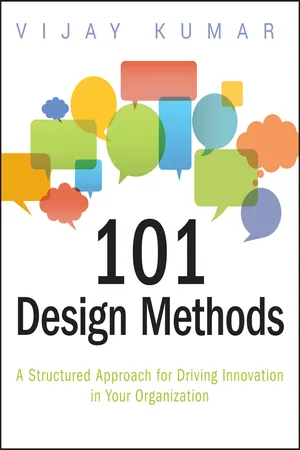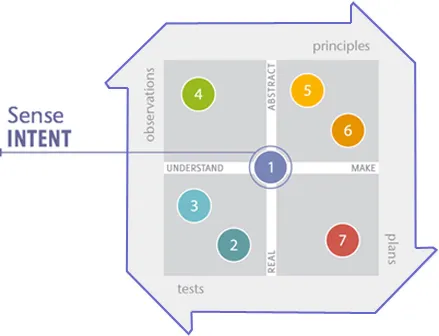
eBook - ePub
101 Design Methods
A Structured Approach for Driving Innovation in Your Organization
- English
- ePUB (mobile friendly)
- Available on iOS & Android
eBook - ePub
About this book
The first step-by-step guidebook for successful innovation planning
Unlike other books on the subject, 101 Design Methods approaches the practice of creating new products, services, and customer experiences as a science, rather than an art, providing a practical set of collaborative tools and methods for planning and defining successful new offerings. Strategists, managers, designers, and researchers who undertake the challenge of innovation, despite a lack of established procedures and a high risk of failure, will find this an invaluable resource. Novices can learn from it; managers can plan with it; and practitioners of innovation can improve the quality of their work by referring to it.
Frequently asked questions
Yes, you can cancel anytime from the Subscription tab in your account settings on the Perlego website. Your subscription will stay active until the end of your current billing period. Learn how to cancel your subscription.
No, books cannot be downloaded as external files, such as PDFs, for use outside of Perlego. However, you can download books within the Perlego app for offline reading on mobile or tablet. Learn more here.
Perlego offers two plans: Essential and Complete
- Essential is ideal for learners and professionals who enjoy exploring a wide range of subjects. Access the Essential Library with 800,000+ trusted titles and best-sellers across business, personal growth, and the humanities. Includes unlimited reading time and Standard Read Aloud voice.
- Complete: Perfect for advanced learners and researchers needing full, unrestricted access. Unlock 1.4M+ books across hundreds of subjects, including academic and specialized titles. The Complete Plan also includes advanced features like Premium Read Aloud and Research Assistant.
We are an online textbook subscription service, where you can get access to an entire online library for less than the price of a single book per month. With over 1 million books across 1000+ topics, we’ve got you covered! Learn more here.
Look out for the read-aloud symbol on your next book to see if you can listen to it. The read-aloud tool reads text aloud for you, highlighting the text as it is being read. You can pause it, speed it up and slow it down. Learn more here.
Yes! You can use the Perlego app on both iOS or Android devices to read anytime, anywhere — even offline. Perfect for commutes or when you’re on the go.
Please note we cannot support devices running on iOS 13 and Android 7 or earlier. Learn more about using the app.
Please note we cannot support devices running on iOS 13 and Android 7 or earlier. Learn more about using the app.
Yes, you can access 101 Design Methods by Vijay Kumar in PDF and/or ePUB format, as well as other popular books in Design & Design General. We have over one million books available in our catalogue for you to explore.
Information
mode 1
SENSE INTENT

WHERE TO PLAY? WHAT TO OFFER? HOW TO WIN? These three questions are at the heart of organizational strategy. Answering them is one of the chief goals of innovation. While the majority of the innovation process in this book is intended to help us answer the last two questions—the what and how—the concept of “Sense Intent” is more about the first—the where. Where is the world moving? In which sector, industry, and market does our organization intend to innovate? In which areas of people’s changing life patterns will our innovation fit? Being in this mode helps us take a pause before jumping into a project and consider the changing world around us. We study the trends causing changes in technology, business, culture, people, markets, and the economy. We frame the problem space through a quick diagnosis of the situation, both inside and outside the organization. We rethink conventions and seek new opportunity areas for innovation. This leads us to set an initial direction and ask where our organization should be moving.

SENSE INTENT
mindsets
The Sense Intent mindset is about continuously detecting the latest changes happening in the world today and forming speculations about what new situations may be looming on the horizon. It is about recognizing what is new or in flux, and identifying hotspots of potential growth. This mindset helps us identify potential opportunities for innovation and form our initial hypotheses. While these hypotheses will be explored and tested in the modes that follow, the goal in this mode is to provide sufficient early direction for research and exploration.


- Mindsets
- Sensing Changing Conditions
- Seeing Overviews
- Foreseeing Trends
- Reframing Problems
- Forming an Intent
Mindset: Sensing Changing Conditions
As creators of the new, innovators need to have the mindset of continuously keeping up with the pace of change whether political, economic, social, cultural, scientific, or technological. Changes, especially in areas where others have not yet fully explored, often indicate fertile ground for innovation. But, in our information-intensive world the challenge of finding new and unexplored opportunities is huge. The torrent of news and data can be overwhelming, and we must think about where to gather information, how to categorize it, and how to relate it to the goals and strategies of the organization. We should actively monitor various information sources—periodicals, websites, books, broadcasts, podcasts—and opinions of leading experts and thought leaders. We should regularly debrief about what these sources and experts are saying, and discuss what trends we see emerging. It is important not only to spot changes in trends but also to understand how those changes have occurred over time, so that we can foresee how changes might happen in the future and tell us something about how our innovations will fit.

Search engine developers like Google have been sensing change patterns and creating powerful tools to search through millions of sources and produce desirable results in fractions of seconds. Equipped with such tools, it is easier to be in the mindset of continuously sensing changing conditions.

Mindset: Seeing Overviews
While in an unfamiliar place, observing surroundings and getting information on the ground helps us navigate in that place. Cues in the environment, landmarks, and street signs are all helpful sources of information for guidance. Also valuable are “overviews,” like street maps, navigation systems that show GPS location, and radio broadcasts about traffic and weather patterns. These big pictures help provide a broader understanding of the place...
Table of contents
- Cover
- Table of Contents
- Title
- Copyright
- FOREWORD
- ACKNOWLEDGMENTS
- INTRODUCTION
- Four Core Principles of Successful Innovation
- A Model of the Design Innovation Process
- Seven Modes of the Design Innovation Process
- Understanding Methods
- mode 1: SENSE INTENT
- Sense Intent: Mindsets
- Sense Intent: Methods
- mode 2: KNOW CONTEXT
- Know Context: Mindsets
- Know Context: Methods
- mode 3: KNOW PEOPLE
- Know People: Mindsets
- Know People: Methods
- mode 4: FRAME INSIGHTS
- Frame Insights: Mindsets
- Frame Insights: Methods
- mode 5: EXPLORE CONCEPTS
- Explore Concepts: Mindsets
- Explore Concepts: Methods
- mode 6: FRAME SOLUTIONS
- Frame Solutions: Mindsets
- Frame Solutions: Methods
- mode 7: REALIZE OFFERINGS
- Realize Offerings: Mindsets
- Realize Offerings: Methods
- CREDITS FOR EXAMPLE PROJECTS
- INDEX
- End User License Agreement